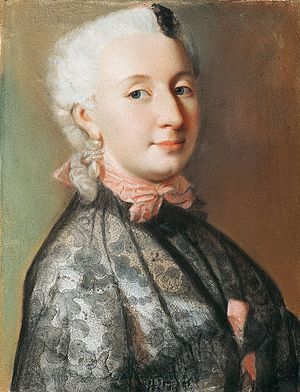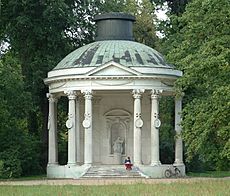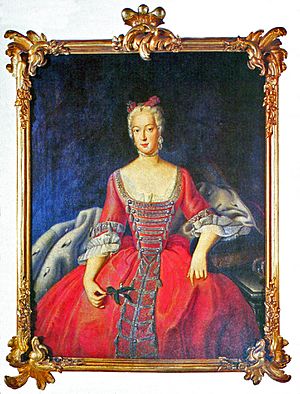Wilhelmine of Prussia, Margravine of Brandenburg-Bayreuth facts for kids
|
||||||||||||||||||||||||||||||
Princess Friederike Sophie Wilhelmine of Prussia (born July 3, 1709 – died October 14, 1758) was a princess from the German Kingdom of Prussia. She was the older sister of Frederick the Great. Wilhelmine was also a talented composer.
She was the oldest daughter of Frederick William I of Prussia and Sophia Dorothea of Hanover. Her grandfather was George I of Great Britain. In 1731, she married Frederick, who was a Margrave (a type of ruler) of Brandenburg-Bayreuth. The beautiful baroque buildings and parks built during her time still make Bayreuth, Germany, look amazing today.
Contents
Early Life in Prussia

Wilhelmine was born in Berlin. She and her brother, Frederick the Great, had a difficult childhood. They remained close friends throughout their lives.
Wilhelmine was treated very badly by her governess when she was young. She later wrote that the governess often hit her. This continued until the governess told their mother that Wilhelmine might become crippled. After hearing this, their mother quickly replaced the governess.
As the oldest daughter, Wilhelmine was often discussed for political marriages. Her mother, Queen Sophia Dorothea, wanted her to marry her cousin, Frederick, Prince of Wales. However, the British side wanted too many things in return, which Wilhelmine's father would not agree to. Her father, King Frederick William I, preferred a marriage with the powerful House of Habsburg.
Her Marriage and New Home
After many marriage plans did not work out, Wilhelmine finally married her relative, Frederick, Margrave of Brandenburg-Bayreuth, in 1731. Frederick was supposed to marry Wilhelmine's younger sister, Sophie. But at the last minute, King Frederick William I decided Wilhelmine should marry him instead. Frederick was not asked about this change.
Wilhelmine only agreed to this marriage because her father threatened her. She also hoped it would help her brother, Frederick, who was in trouble at the time. At first, the marriage was happy. But later, they faced money problems. Also, Frederick became interested in another woman, Dorothea von Marwitz. This made Wilhelmine's brother, Frederick the Great, very upset and caused a three-year break in his friendship with Wilhelmine.
Becoming a Margravine
When Wilhelmine's husband became the ruler (Margrave) in 1735, they began to transform Bayreuth. They wanted to make it a small version of the famous Palace of Versailles. Their building projects were very grand.
They rebuilt their summer home, which is now part of the Hermitage Museum. They also rebuilt the main Bayreuth opera house and built a second, new one. They added a theater and reconstructed the Bayreuth palace. The unique Bayreuth Rococo style of architecture from this time is still famous. They also helped start the University of Erlangen. All these big projects almost made their court run out of money.
Wilhelmine made Bayreuth an important center for thinkers and artists in the Holy Roman Empire. She surrounded herself with clever people. Famous visitors like Voltaire and Frederick the Great sometimes came to her court, adding to its fame.
Wilhelmine's brother Frederick gave her money in exchange for troops, just like he did with his other sisters. When the Seven Years' War began, Wilhelmine became more involved in diplomacy. Austrian leaders tried to convince Bayreuth to join their side against Prussia. In September 1745, during the Silesian war, Wilhelmine met with Maria Theresa of Austria. This almost ruined her close relationship with her brother.
In 1750, Wilhelmine visited the Prussian court for several weeks. She met famous people like Voltaire. In June 1754, she and Frederick met for the last time. Frederick promised her his loyalty forever. She continued to help her brother by gathering information in southern Germany.
Wilhelmine died in Bayreuth on October 14, 1758. This was the same day Frederick lost a battle to Austrian forces. Frederick had lost many friends and family members, but Wilhelmine's death affected him the most. He was very sick for a week and became very sad. He never fully recovered from his sadness.
Ten years after her death, her brother, who was still very sad, built the Temple of Friendship at Sanssouci to remember her.
Her Musical Works
Besides her other achievements, Wilhelmine was a talented composer and loved music. She played the lute and was a student of Sylvius Leopold Weiss. She also hired the musician Bernhard Joachim Hagen.
One of her known works is the Keyboard Concerto in G minor.
- Allego, G minor.
- Cantabile, B flat major.
- Gavottes I & II, G minor.
The flute part in this concerto could have been played by her brother or her husband, as both played the flute.
She also composed an opera called Argenore around 1740. It was performed for her husband's birthday. She also wrote Cavatinen (short songs) and a Flute Sonata. Some of her other chamber music still exists today.
Her Only Child
Wilhelmine had only one child, a daughter named Elisabeth Fredericka Sophie of Brandenburg-Bayreuth. She was born on August 30, 1732. People said she was the most beautiful princess in Germany. In 1748, she married Karl Eugen, Duke of Württemberg. Elisabeth Fredericka Sophie died on April 6, 1780, and did not have any children who survived her.
Her Memoirs
Wilhelmine wrote her life story, called Memoires de ma vie, in French. She worked on it between 1748 and her death. These memoirs are kept in the Royal Library of Berlin. They were first printed in 1810. Later, an English translation was published in 1904. The writer William Thackeray suggested reading her memoirs if you are interested in European court history.
Images for kids
-
Portrait by Jean-Étienne Liotard
-
Wilhelmine with her brother Frederick, as children
See Also
 In Spanish: Guillermina de Prusia para niños
In Spanish: Guillermina de Prusia para niños








